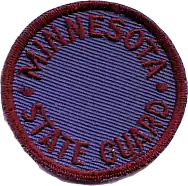Minnesota State Guard
The Minnesota State Guard, also known previously as the Minnesota Defense Force, is the currently inactive state defense force of the state of Minnesota. The State Guard was organized with the purpose of replacing the Minnesota National Guard in protecting the state of Minnesota while the National Guard was federalized and deployed during World War II. The State Guard is authorized under Minnesota law, and is recognized as a component of the organized militia of Minnesota, along with the Minnesota National Guard.[2]
| Minnesota State Guard | |
|---|---|
 The shoulder patch worn on the Minnesota State Guard uniform during World War II. | |
| Active | 1941-1948 |
| Country | |
| Allegiance | |
| Branch | Army |
| Type | |
| Role | Military reserve force |
| Size | 6,100 (1942)[1] |
| Commanders | |
| Current commander | Governor of Minnesota |
History
World War I
The state of Minnesota authorized and created state defense forces during each of the world wars. As a response to the United States' entrance into World War I, the United States Congress passed the Home Guard Act of 1917, which allowed the states to create home guards, which could receive surplus weaponry from the federal government.[3] Minnesota's first State Guard, known officially as the Minnesota Home Guard, was created on April 28, 1917, and served for the duration of World War I.[4] Over the course of the war, the Home Guard eventually consisted of 23 battalions with more than 7,000 men.[5] The Home Guard included the Sixteenth Battalion, which was the first Minnesota-recruited African American military unit in the state's history.[6]
The Home Guard handled a number of domestic emergencies. In late 1917, the Home Guard was deployed to restore order following riots in St. Paul.[7] On July 1, 1918, a tornado struck the town of Tyler; the relief effort was carried out by members of the Home Guard and National Guard.[4] In October 1918, the Home Guard assumed management of the aftermath of the Cloquet fire.[5] The remaining elements of the Home Guard were dissolved in December of 1920.[4]
World War II
In 1940, prior to the United States' entry into World War II, Section 61 of the National Defense Act of 1916 was modified to allow the establishment of state defense forces.[8] The Minnesota State Guard was created in 1941.[9] By 1942, the State Guard had reached a strength of approximately 6,100 members.[1] By 1942, the First Separate Infantry Battalion of the Minnesota State Guard was placed on active duty, requiring prospective members to enlist for the duration of the war plus an additional six months.[10] The battalion was responsible for providing full-time security for Duluth, Two Harbors, and the Thomson Dam in Jay Cooke State Park.[11] In at least one event, members of the Minnesota State Guard competed in a rifle competition against students from the Shattuck Military School.[12]
In 1948, two battalions of Minnesota State Guard, equipped with one dozen M4 Sherman tanks, were deployed to quell a violent strike by the meat packer's union in the St. Paul and Newport areas.[13] After the violence was quelled, troops withdrew from most of their deployed zones but continued to patrol the Wilson plant in Albert Lea, Minnesota.[14]
Legal status
State defense forces are authorized by the federal government under Title 32, Section 109 of the United States Code.[15] Minnesota law also allows the creation of a state defense force.[2]
References
- Alexander, Jack (19 October 1942). "Governor Stassen: The Republican Party's Minnesota Hopeful Plans to Get Re-elected and Then Join the Navy". Life. Time Inc. 13 (16): 127. Retrieved 3 September 2015.
- "190.06 Militia; MEMBERS; EXEMPTIONS". The Office of the Revisor of Statutes. Retrieved 3 September 2015.
- "Home guards, arming, etc., 40 Stat. 181" (PDF). Legis Works. Archived from the original (PDF) on November 3, 2015. Retrieved 5 August 2020.
- "Minnesota Home Guard". MNopedia. Retrieved 5 August 2020.
- DeCarlo, Peter J. (2017). "Loyalty Within Racism: The Segregated Sixteenth Battalion of the Minnesota Home Guard During World War I". Minnesota History. 65 (6): 201, 216. JSTOR 26368707.
- "16th Battalion, Minnesota Home Guard". MNopedia. Retrieved 5 August 2020.
- Woltman, Nick (2 December 2017). "How the 1917 streetcar riots shook St. Paul and reshaped Minnesota politics". St. Paul Pioneer Press. Retrieved 5 August 2020.
- Sieg, Dr. Kent G. "America's State Defense Forces: An Historical Component of National Defense" (PDF). Defense Technical Information Center. Retrieved 3 September 2015.
- "Adjutant General: National Guard: An Inventory of Its State Guard Records at the Minnesota Historical Society". Minnesota Historical Society. Retrieved 3 September 2015.
- "Recruits Being Sought For Minnesota State Guard". Lake Benton News. Lake Benton, Minnesota. Retrieved 3 September 2015.
- "State Guard Recruiter in New Ulm Next Monday". Lafayette Ledger. Lafayette, Minnesota. 6 November 1942. Retrieved 3 September 2015.
- "20 Years Ago: 1946". Lawrence Daily Journal. Lawrence, Kansas. 6 August 1956. Retrieved 3 September 2015.
- Thomis, Wayne (15 May 1948). "Minnesota Guard Moves to Scene of CIO Mob Attacks". Chicago Tribune. Chicago, Illinois. Retrieved 3 September 2015.
- "Meat Strike Ends, Troops Withdrawn". The Owosso Argus-Press. Chisago County, Minnesota. 22 May 1948. Retrieved 3 September 2015.
- "32 U.S. Code § 109 - Maintenance of other troops". Legal Information Institute. Cornell University Law School. Retrieved 3 September 2015.